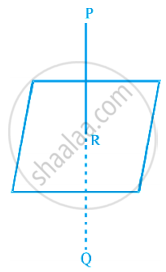Advertisements
Advertisements
Question
Find the image of the point having position vector `hati + 3hatj + 4hatk` in the plane `hatr * (2hati - hatj + hatk)` + 3 = 0.
Solution
Let the given point be P`(hati + 3hatj + 4hatk)` and Q be the image of P in the plane `hatr * (2hati - hatj + hatk)` + 3 = 0 as shown in the figure.

Then PQ is the normal to the plane.
Since PQ passes through P and is normal to the given plane
So the equation of PQ is given by `vecr = (hati + 3hatj + 4hatk) + lambda(2hati - hatj + hatk)`
Since Q lies on the line PQ, the position vector of Q can be expressed as `(hati + 3hatj + 4hatk) + lambda(2hati - hatj + hatk)`
i.e., `(1 + 2lambda)hati + (3 - lambda)hatj + (4 + lambda)hatk`
Since R is the mid point of PQ, the position vector of R is
`([(1 + 2lambda)hati + (3 - lambda)hatj + (4 + lambda)hatk] + [hati + 3hatj + 4hatk])/2`
i.e., `(lambda + 1)hati + (3 - lambda/2)hatj + (4 + lambda/2)hatk`
Again, since R lies on the plane `vecr * (2hati - hatj + hatk)` + 3 = 0
We have `{(lambda + 1)hati + (3 - lambda/2)hatj + (4 + lambda/2)hatk} * (2hati - hatj + hatk) + 3` = 0
⇒ λ = –2
Hence, the position vector of Q is `(hati + 3hatj + 4hatk) - 2(2hati - hatj + hatk)`
i.e. `-3hati + 5hatj + 2hatk`.
APPEARS IN
RELATED QUESTIONS
Three vertices of a parallelogram ABCD are A (3, –1, 2), B (1, 2, –4) and C (–1, 1, 2). Find the coordinates of the fourth vertex.
Name the octants in which the following points lie:
(–5, –4, 7)
Find the image of:
(–5, 4, –3) in the xz-plane.
Find the image of:
(–4, 0, 0) in the xy-plane.
Find the distances of the point P(–4, 3, 5) from the coordinate axes.
Determine the points in zx-plane are equidistant from the points A(1, –1, 0), B(2, 1, 2) and C(3, 2, –1).
Find the points on z-axis which are at a distance \[\sqrt{21}\]from the point (1, 2, 3).
Show that the points A(1, 2, 3), B(–1, –2, –1), C(2, 3, 2) and D(4, 7, 6) are the vertices of a parallelogram ABCD, but not a rectangle.
Find the ratio in which the sphere x2 + y2 + z2 = 504 divides the line joining the points (12, –4, 8) and (27, –9, 18).
Write the distance of the point P(3, 4, 5) from z-axis.
The coordinates of the mid-points of sides AB, BC and CA of △ABC are D(1, 2, −3), E(3, 0,1) and F(−1, 1, −4) respectively. Write the coordinates of its centroid.
The ratio in which the line joining (2, 4, 5) and (3, 5, –9) is divided by the yz-plane is
Let (3, 4, –1) and (–1, 2, 3) be the end points of a diameter of a sphere. Then, the radius of the sphere is equal to
The coordinates of the foot of the perpendicular drawn from the point P(3, 4, 5) on the yz- plane are
The perpendicular distance of the point P(3, 3,4) from the x-axis is
The length of the perpendicular drawn from the point P(a, b, c) from z-axis is
Find the direction cosines of the line passing through the points P(2, 3, 5) and Q(–1, 2, 4).
If a line makes an angle of 30°, 60°, 90° with the positive direction of x, y, z-axes, respectively, then find its direction cosines.
The x-coordinate of a point on the line joining the points Q(2, 2, 1) and R(5, 1, –2) is 4. Find its z-coordinate.
Find the co-ordinates of the foot of perpendicular drawn from the point A(1, 8, 4) to the line joining the points B(0, –1, 3) and C(2, –3, –1).
If a line makes angles `pi/2, 3/4 pi` and `pi/4` with x, y, z axis, respectively, then its direction cosines are ______.
If a line makes an angle of `pi/4` with each of y and z axis, then the angle which it makes with x-axis is ______.
Find the equation of a plane which bisects perpendicularly the line joining the points A(2, 3, 4) and B(4, 5, 8) at right angles.
Find the equations of the two lines through the origin which intersect the line `(x - 3)/2 = (y - 3)/1 = z/1` at angles of `pi/3` each.
If a variable line in two adjacent positions has direction cosines l, m, n and l + δl, m + δm, n + δn, show that the small angle δθ between the two positions is given by δθ2 = δl2 + δm2 + δn2
Show that the straight lines whose direction cosines are given by 2l + 2m – n = 0 and mn + nl + lm = 0 are at right angles.
The area of the quadrilateral ABCD, where A(0, 4, 1), B(2, 3, –1), C(4, 5, 0) and D(2, 6, 2), is equal to ______.
The vector equation of the line `(x - 5)/3 = (y + 4)/7 = (z - 6)/2` is ______.
